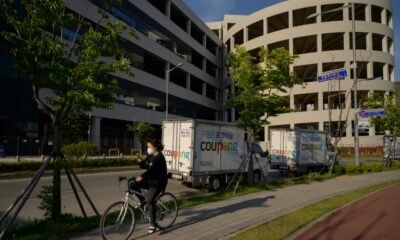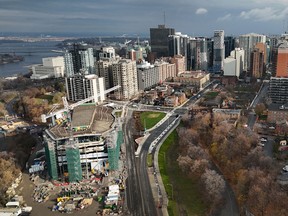Top Stories
South Korea’s Economy Slumps to Lowest Growth Since 2020

UPDATE: South Korea’s economy is projected to grow at a sluggish 0.9% in 2025, marking the slowest pace since the pandemic-induced downturn in 2020. This alarming forecast comes as fears mount over potential disruptions from increasing US tariffs that could severely impact the nation’s export-driven economy.
Latest reports from the government indicate that while exports showed resilience in the first half of the year, they are expected to decline following a recent trade agreement with Washington. Specifically, exports to the US dropped by 2.7% in the first 20 days of August, signaling a loss of momentum after a modest 1.4% increase in July.
The fragile state of South Korea’s economy is compounded by rising protectionism and significant domestic challenges, including high household debt and weak construction activity. As a crucial player in global supply chains, particularly in semiconductors and automotive sectors, South Korea’s economic trends are critical for international markets.
Officials are actively monitoring economic indicators, with discussions underway regarding potential monetary policy adjustments. The Bank of Korea will meet on August 28 to consider a possible cut in the benchmark interest rate, as indicated by Governor Rhee Chang Yong following last month’s policy meeting.
In response to these economic challenges, President Lee Jae Myung has announced a robust fiscal strategy, approving an additional budget of 31.8 trillion won (approximately $23.3 billion) to bolster the economy against external trade headwinds. Additionally, the government plans to unveil a support package worth 45.8 trillion won to enhance supply chain resilience.
Deputy Finance Minister Yoon Indae emphasized, “There is no room to retreat,” highlighting the administration’s commitment to stimulate growth. Employment is expected to rise by 170,000 this year, driven by gains in the service sector, albeit offset by losses in construction and manufacturing.
Inflation is projected to hover around 2%, aided by declining energy prices, but geopolitical tensions and erratic weather patterns could reignite inflationary pressures. The current account surplus is anticipated to reach $95 billion in 2025, up from previous estimates, but is expected to narrow to $80 billion by 2026.
Looking forward, the government has laid out an ambitious 210 trillion won fiscal plan for 2026-2030, focusing on innovation and economic growth, aiming to raise South Korea’s potential growth rate to 3%.
As the nation navigates these turbulent economic waters, all eyes will remain on the upcoming policy decisions and their implications for both South Korea and the global economy. Share this story to keep others informed about the latest developments impacting South Korea’s economic landscape.
-

 Politics4 weeks ago
Politics4 weeks agoSecwepemc First Nation Seeks Aboriginal Title Over Kamloops Area
-

 World5 months ago
World5 months agoScientists Unearth Ancient Antarctic Ice to Unlock Climate Secrets
-

 Entertainment5 months ago
Entertainment5 months agoTrump and McCormick to Announce $70 Billion Energy Investments
-

 Science5 months ago
Science5 months agoFour Astronauts Return to Earth After International Space Station Mission
-

 Lifestyle5 months ago
Lifestyle5 months agoTransLink Launches Food Truck Program to Boost Revenue in Vancouver
-

 Technology3 months ago
Technology3 months agoApple Notes Enhances Functionality with Markdown Support in macOS 26
-

 Lifestyle3 months ago
Lifestyle3 months agoManitoba’s Burger Champion Shines Again Amid Dining Innovations
-

 Top Stories2 months ago
Top Stories2 months agoUrgent Update: Fatal Crash on Highway 99 Claims Life of Pitt Meadows Man
-

 Politics4 months ago
Politics4 months agoUkrainian Tennis Star Elina Svitolina Faces Death Threats Online
-

 Sports5 months ago
Sports5 months agoSearch Underway for Missing Hunter Amid Hokkaido Bear Emergency
-

 Politics5 months ago
Politics5 months agoCarney Engages First Nations Leaders at Development Law Summit
-

 Technology5 months ago
Technology5 months agoFrosthaven Launches Early Access on July 31, 2025





















